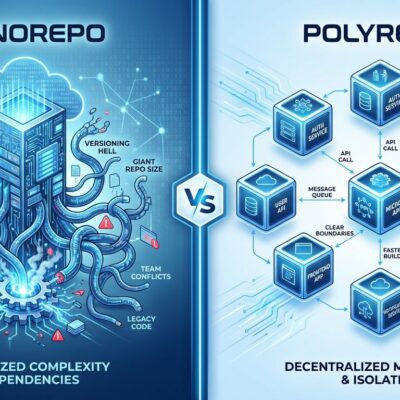
After 15 years of dominance, Node.js is obsolete for new projects. Bun crossed the production-ready threshold with Bun 1.0 in September 2023, and the evidence is overwhelming: 3-4x faster performance, comprehensive framework support, and all-in-one tooling that eliminates JavaScript’s notorious tool fragmentation. Teams choosing Node.js for new projects aren’t making the safe choice—they’re choosing slow on purpose.
Performance Isn’t Marginal, It’s Transformational
The performance gap isn’t 10% faster—it’s a different class entirely. Bun’s benchmarks show Next.js dev server starts in 1.5-2 seconds compared to Node’s 5-8 seconds. Test suites that take 45 seconds with Jest run in 15 seconds with Bun. Package installation drops from 30-45 seconds to 8-12 seconds. This is 3-4x faster across the board, not synthetic benchmarks—real-world workloads.
The speed difference comes from architectural choices. Bun uses JavaScriptCore (Apple’s WebKit engine) instead of V8, and implements the runtime in Zig rather than JavaScript. Consequently, the result is faster startup, lower memory usage (40-50% less than Node for the same Express server), and performance that compounds throughout the development cycle. Faster tests plus faster builds plus faster startup equals massive daily time savings.
Developers migrating from Node describe it as “going back to dial-up internet” when they return. One team reported their test suite dropped from 2 minutes to 30 seconds. That’s not marginal improvement—it’s transformational.
The All-in-One Promise Actually Delivered
Node.js ecosystem fragmentation is exhausting. Should you use npm, yarn, or pnpm? Webpack or vite? Jest or vitest? Each choice adds configuration files, documentation to read, and cognitive overhead. However, Bun consolidates everything: runtime, bundler, test runner, and package manager in one tool.
Compare a typical Node.js workflow to Bun. With Node, you install npm (or choose between three package managers), configure webpack or vite for bundling, set up jest for testing, and configure TypeScript compilation. With Bun, you install Bun. That’s it. bun run executes code, bun install manages packages, bun test runs tests, and bun build bundles. Native TypeScript support means no tsconfig needed for basic usage.
This pattern is identical to UV consolidating Python’s fragmented tooling (pip, virtualenv, poetry, pyenv into one Rust-based tool). Rust and Zig implementations are disrupting entrenched ecosystems by delivering undeniable performance gains and eliminating tool proliferation.
Framework Support Killed the “Not Ready” Argument
Bun 1.0 launched in September 2023 as a production-stability declaration. It’s been over a year of production deployments. The “not ready” argument expired.
Major frameworks officially support Bun: Next.js, Remix, SvelteKit, Nuxt, and Astro all document Bun compatibility. Framework teams wouldn’t invest engineering time adding support for an unstable runtime. When Next.js officially supports Bun, that signals production readiness.
Moreover, Bun 2.0 removed the last major barrier by adding Windows support. Previously, Linux and macOS only adoption was limited. Now, Windows developers can use Bun without virtualization. Combined with 90,000+ GitHub stars and active development, the project shows no signs of abandonment or instability.
If your objection to Bun is “it’s not production ready,” you’re arguing based on 2022 data. The ecosystem has moved on.
Node Loyalist Arguments Don’t Hold Up
Let’s address the common defenses of Node.js directly.
“Ecosystem maturity matters more than speed.” Bun uses npm packages—the same ecosystem. Compatibility is 95%+, with only edge cases around native C++ modules causing issues. Most problematic packages have pure-JavaScript alternatives now. Bun didn’t create a new ecosystem; it optimized access to the existing one.
“Production risk is too high.” Bun 1.0 was specifically the production-ready milestone, released September 2023. Over a year of production usage validates stability. Major frameworks wouldn’t document support if the runtime were unstable. Early adopter risk was valid in 2022—it’s minimal now.
“Better to wait and see.” Waiting has costs. Every day spent with Node is a day of slower tests, slower builds, and slower startup times. Developer productivity matters. The question isn’t whether Bun will succeed—it’s how much time you’ll waste before switching.
“Node.js will catch up eventually.” Node has been optimizing for years, and gains are marginal. V8 improvements have plateaued. Bun’s Zig foundation is architecturally faster—Node can’t catch up without a complete rewrite. The performance gap will widen, not narrow.
Why Teams Still Choose Node (And Why They Shouldn’t)
The real reason teams choose Node for new projects isn’t technical merit—it’s organizational inertia. “We’ve always used Node” isn’t a technical argument. Familiarity is comfortable, but comfort has a cost: wasted developer time, slower feedback loops, and fragmented tooling.
For legacy projects with complex native dependencies, sticking with Node is defensible. However, for new greenfield projects? Choosing Node commits you to slower tools for years. Node isn’t getting faster. Bun is actively improving.
The migration path for skeptics is simple: start small. Try Bun for your testing infrastructure first (fastest wins). Use it in development environments before production. Start a new microservice with Bun instead of migrating the monolith. Worst case, switching back to Node takes five minutes. Best case, you never wait for slow npm installs again.
JavaScript developers have watched Python’s pip-to-UV migration happen in real time. The pattern is identical: entrenched tool, Rust-based replacement, massive performance gains, all-in-one consolidation, initial skepticism, then rapid adoption. Bun is following the same trajectory.
Node.js had its run. It powered the JavaScript renaissance, proved JavaScript could scale on the server, and built a massive ecosystem. But being first doesn’t mean staying best. Bun is faster, simpler, and production-ready. The only question left is how long you’ll wait before switching.
Key Takeaways
- Bun delivers 3-4x faster performance than Node.js with over a year of production stability since Bun 1.0 (September 2023)
- Major frameworks (Next.js, Remix, SvelteKit, Nuxt, Astro) officially support Bun, validating production readiness
- All-in-one tooling consolidates runtime, bundler, test runner, and package manager—eliminating JavaScript ecosystem fragmentation
- Node loyalist arguments (ecosystem maturity, production risk, “wait and see”) don’t withstand scrutiny based on current evidence
- Choosing Node.js for new projects is organizational inertia, not technical merit—try Bun on your next greenfield project












